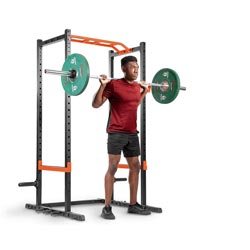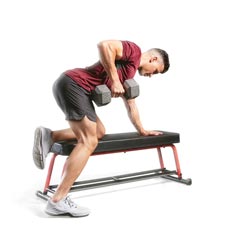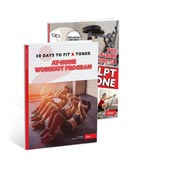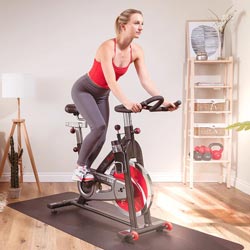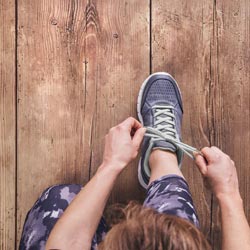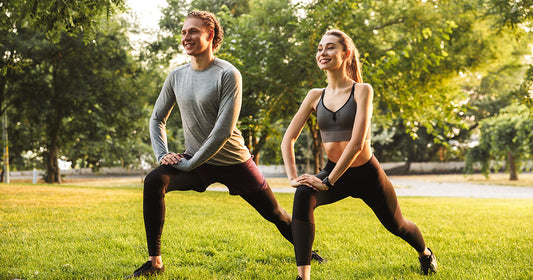If you’ve taken a fitness class, you’ve likely heard an instructor call out to ‘engage your core’ throughout your workout. It’s a phrase that’s used time and time again in the fitness world, yet so many people don’t understand exactly what it means or how to do it.
As fitness professionals, we stress engaging your core because we know that with so many exercises and activities a connected core is the key to proper form and quality movement.
Unfortunately, it’s not always easy to pause a class to break down exactly how to do it, which might leave you hoping you’re engaging your core, but not quite sure if you are or not.
So, how can you achieve the ever-elusive ‘engaged core’? In this article, I’ll break down not only how to engage your core, but also give you all the details so you can make your workouts more effective!
What is Your Core?
When you hear the term ‘core’, what comes to mind? For most, the initial answer is your abs. However, your core includes much more than just your abs, in fact, it includes all the muscles that connect and support your spinal column and pelvis.
That means your core includes your abs, obliques, glutes, and back muscles. More specifically:
- Abdominals: Rectus Abdominis and Transversus Abdominis
- Obliques: Internal and External Obliques
- Gluteal Complex: Gluteus Maximus, Gluteus Minimus and Gluteus Medius
- Hip Complex: Hip Adductors and Abductors
- Lower Back Complex: Quadratus Lumbar, Spinal Erectors, and Multifidus
- Mid Back: Latissimus Dorsi
- Upper Back: Trapezius and Rhomboids
You can likely assume based on the sheer number of muscles listed above, that the core is not as simple as it appears. The act of engaging your core often involves many of these muscles working together to achieve proper posture and protect your spine.
What Does ‘Engage Your Core’ Mean?
Engaging your core means bracing and tightening all the muscles in your core (see above) to keep your spine safe and stable. Picture everything from your rib cage to your pelvis locked into place.
I like to imagine bracing myself as if someone was going to give me a punch in the stomach. Rather than sucking in your stomach, you’re going to take a nice, big deep breath, and tighten your entire core.
For some the visual of tightening your abdominals like tightening a corset, or ‘zipping’ your abs from your belly button up towards your spine helps.
Once you’re able to find that engaged core position, remember you should always be able to breathe with your core engaged. Breathing is one of the most important elements of nailing the engaged core position because you need to be able to continue breathing normally while keeping your core tight.
How to Engage Your Core
Above you got a taste of how engaging your core works, but here I’d like to break it down into more specifics. Below, I’ve listed an exercise you can use to find a braced core position. Once you find it, it will be a lot easier to practice it during other exercises and activities.
Engage Your Core in 3 Steps
1. Lie Down on Your Back
Start lying down flat on your back with knees bent and feet rooted to the ground at a comfortable distance from your butt.
2. Take a Deep Breath in Through Your Nose into Your Belly
Take a deep breath in through your nose and fill your belly with air.
3. Exhale & Brace Your Core
Exhale your breath while bracing your core. What you’ll find from this position is your lower back will maintain contact with the floor, and you’ll feel your ab muscles engaged.
Imagine there’s a $100 bill beneath the natural arch of your spine, and it’s a windy day. When properly engaged you should be activating your core to press your back against the floor and protect that sweet money at all costs.
Examples of Engaging Your Core
Now keep in mind, keeping your core engaged through different exercises or activities might be a bit more challenging than the exercise above when you go to put this into practice. Be patient with yourself and keep trying. Remember that every single breath you take is a chance to re-engage those core muscles for that rock-solid center.
Below, I’ve included 3 great examples of engaging your core in real life and your workouts. Give these a try!
Seated Posture

Every day, most of us do a lot of sitting. You may find yourself starting to get a little too comfortable, slouching in your chair, hunching your shoulders. Sound familiar?
If so, you probably deal with a tight back, shoulders, or neck from time to time. Try sitting with a good posture. Grab a chair, and practice now.
Start by sitting normally. Now, sit up, keep your chest up, engage your core, and roll the shoulders down and back. This is an engaged core, and this is the position you should be sitting in whenever you’re seated throughout the day.
Plank

The infamous plank - core central! A plank is perfect for practicing engaging your core because it’s an isometric move focused entirely on core engagement.
Even better, it’ll help teach you how the glutes are an important and integral piece of engaging your core when used properly.
When in your plank bring your hips down, engaging the glutes and hamstrings, pressing your heels away from your body.
As you engage the glutes, drawing the hips down in line with your spine, feel how that motion connects with your abs as you tighten and brace your abdominal muscles, zipping your belly button up towards your spine.
Finally, focus on your back, ensuring your hands (if doing a standard plank) or elbows (if doing a forearm plank) are directly below your shoulders. Squeeze the shoulder blades back and together, ensuring your chest is open and your upper back is not rounding.
Note how your abdominals, glutes, and back all work together to pull off this classic core move! Put it all together by practicing breathing while you hold your plank.
Deadlift

Finally, let’s break down deadlifts. Deadlifts are one of the most popular exercises for full body strength and improving the quality of your movement. Nailing this move is extremely applicable to everyday life, and you’ll start noticing the crossover once you get it down.
However, it’s one of the most common exercises that people struggle with when it comes to injuries. Often, people will overextend or overarch their back at the top of this exercise, rather than just maintaining a neutral spine position.
To maintain this neutral spine position, simply brace the abs, and squeeze your glutes - core engagement coming in, once again, to save the day.
The combination of glutes and abs working in tandem to help you maintain good posture and movement integrity is something you’ll start to see as a recurring theme in your workouts time and time again. Get this down, and it will have major benefits for not only your deadlifts but well beyond!
Why is Engaging Your Core Important?
Engaging your core is important simply because of the many benefits it has for your body. When you properly engage your core, you’ll experience these benefits not just in your workouts, but in everyday life. Below are 3 of my favorite benefits of properly engaging your core.
3 Benefits of Engaging Your Core
1. Move Better
Put quite simply, engaging your core helps you move better. Most of the movements you complete daily require good posture, which is an engaged core position through and through. Understanding how to brace your core can improve the way you move all day long.
Engaging your core can also help improve your workout performance. A strong and stable core is a grounding center for powerful movements. The act of engaging your core allows the transfer of more power to your extremities (arms and legs).
2. Improve Balance & Stability
A properly engaged core can improve your balance and stability during everyday life and your workouts. Whether you’re aging and looking to reduce your risk of fear of falling, or you’re young and looking to make serious gains - balance and stability are incredibly important to help you reach your goals. If you’re ready to gain confidence, it all starts with an engaged core.
3. Reduce Injury
The most common injury we face day to day is lower back injury. So bracing your core will help protect your spine. Engaging your core is important when there is potential for your spine to overarch, extend, bend or rotate.
So, this means you should think about engaging your core not just during workouts or sports, but also during everyday activities like when you bend down to tie your shoes, pick up your groceries, or lift your child into your arms.
In Closing
By learning how to engage your core and properly apply it to daily life as well as your workouts, you’ll be moving better all day long!

